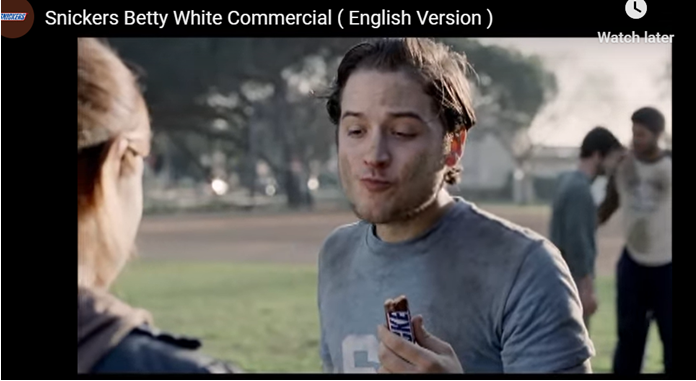Later this month, I am serving on a panel that will discuss how Pharma companies develop “great DTC creative”. While there is no recipe for great advertising (in general), the tactics leading to the goal are the same. Draw attention, make it relevant, deliver a powerful (and if possible distinctive message) and spark action. Basically get the patient to talk with a doctor. When it is done right, DTC advertising delivers an excellent ROI.
For consumer goods, an example of great advertising is the “Like Betty White” Commercial that promoted Snickers. The creative device is a humorous connection between Betty White and the target customer (“Mike”). The TV ad is both memorable and relevant. Don’t be like Betty White, eat snickers, get an energy boost, be cool, play better football.
Is Great DTC Adverting Bold?
While many people (especially advertising agencies) hope for bold DTC creative, it does not happen very often. That is because it either cannot be approved for use or it is not very successful.

Chantix provides a recent example of “funky” advertising creative. Referring to the old chestnut, “going cold turkey”, Chantix questions that appropach. It lets patients know that with its help, patients can quit “slow turkey”. While some patients may find this cute or clever, others may be turned off by the silly reference to their addiction. Like the Snickers ad, Chantix probably draws attention at first. However, unlike Snickers it may miss the mark on relevance and delivery of a compelling message. If the DTC advertising is bold and relevant, it will be effective. Otherwise not.
So What are the Elements of Great DTC Advertising?
Over the past 20 years, we have noted characteristics of DTC advertising which are most likely to produce successful outcomes. These include:
- Quickly introduce information about the condition – to gain specific patient attention
- Visualize the problem (making it relatable to patients) leading into description of the solution
- Use a strong branding device (for Chantix this is the turkey) – that is relevant and ownable
- Show relatable (not unusual) situations. While showing backyard scenes can be boring, it is better to show these compared to surreal imagery found in some DTC advertising
- Show the brand name throughout the ad
- Be distinctive. While this is often very difficult in contested categories, this is where good creative can make all the difference
- When possible, use a demo that shows how the medication can help with the condition
- If appropriate use testimonials – patients react well to these
- If possible, show positive interaction between patients and the HCPs. In this way, DTC advertising can also deliver a positive ROI among the HCPs
In many categories, DTC advertising struggles to differentiate brands. Some complain that DTC advertising does not do enough thinking “outside the box”. These pundits claim that sharp creative would produce strong results. We do not disagree. Occasionally Pharma comes up with very clever ideas, like the “Tubs” used to promote Cialis. However, that should be considered an aspirational outlier. If the advertising can work within the primary guidelines above and leverage a strong branding device (Tubs), great. Otherwise, it is smarter to develop safe and distinctive advertising.
At the Minimum, Great DTC Advertising Should Catch Their Attention

It was always important to quickly introduce the condition and brand. Now that requirement is critical. In most cases patients will have an opportunity to tune advertising out, or to skip it entirely at the very start. On YouTube you have exactly 5 seconds. If the advertising is not relevant to the target, they will skip. And a very large percentage do skip. Given this hurdle, it is amazing to see that many DTC ads continue to build a slow story – sometimes vaguely referring to the problem before talking about the condition. As the clock ticks, viewers skip.

Entyvio DTC Ad Has Strong Elements
Entyvio offers a good example of Great DTC advertising. Right out of the gate (“0” seconds) the spot says, “With moderate to severe ulcerative colitis or crohn’s disease, your plans can change at any time…” Only 1% of the US population suffers from this disease, so the makers want to be sure that the target knows immediately that the ad is for them. This significantly increases the likelihood that the patient will continue to watch the ad past 5 seconds.
Describing Condition and MOA

In its ad, Entyvio also deploys a very effective tactic. It explains that Entyvio is “GI focused” on the problem introduced at the start of the ad. “Entyvio is made for this.” It goes on to say, “Entyvio works specifically in the GI tract to prevent an excess of white blood cells from entering and causing inflammation.”
Patient interest in this type of information, especially when it is creatively visualized like this, is very high. It will trigger both interest and discussion with a doctor.
Great DTC Patient Education
We are also seeing examples of strong DTC advertising that focuses on developing patient awareness of conditions. GSK recently launched a campaign to build awareness of Shingles. One in three adults over the age of 50 experience this condition, but most of them do not realize it. Thus it is critical for the ad to quickly draw attention to the problem and make it relevant to the patient. “Shingles doesn’t care” says the ad. You need to protect yourself against this serious medical condition.
There are many other examples of successful DTC advertising. Most of them deploy variations on the tactics described above. Some are more exciting than others. Our research shows that being exciting is not a prerequisite to being effective.
We acknowledge that it may be possible to violate all of the suggestions we identify above and still produce a great DTC ad. However, so far as we know it has not happened yet.


